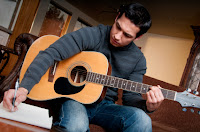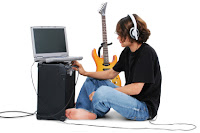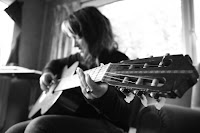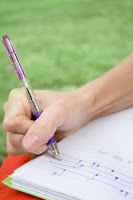So I have posted several articles with examples of guitar tablature, but I haven't focused on standard notation is much. Granted, most guitarists become more comfortable with guitar tab in their career, but standard notation is just as important if not more in the career of a guitarist. So in this post I feature standard music notation, tips on writing in standard notation, and even a notebook to write down concepts on the fly. Standard notation is the best way for guitarists to collaborate with other musicians since it is the written choice of nearly every other instrument and vocalist.
 |
| Guitarist and songwriter |
Let's start out by stressing the importance of standard notation. This piece is short, but to the point. Check it out at
http://www.blackbeltguitar.com/news/show_news.php?subaction=showfull&id=1073715574&archive=.
Decide now to learn to read standard notation for guitar, and you'll open doors that remain locked to all self-taught players who may spend a lifetime in musical illiteracy. If you think it is a waste of time, it might be because nobody has been able to show you the way to learn.
The very best players all know how to read and write music, because they put the time in to learn how. Steve Vai is particularly emphatic about the importance of learning how to read standard notation, because not all instruments in the band can use tablature. Think of other greats, such as Chet Atkins, George Benson, Steve Morse, who can read and play in real time.
I don't wanna fool ya... you just can't learn to read music by scavenging free lessons, downloading tablature or just picking up a score and staring at it. None of these methods provides the necessary hand, ear, eye training you need to really get comfortable.
This book has all the exercises in the right doses and in the right order that you will need. It is not an overnight skill, but with a few minutes a day, and by the end of the year, you'll be reading as fluently as the pros do.
Now onto a fundamental lesson in reading standard notation. This should boost your knowledge of reading music tremendously. Take a look here at
http://ezinearticles.com/?The-Origin-of-the-Modern-Music-Staff&id=5486211.
The written notation of music is a foundational part of today's musical entertainment providing a method for musicians to play instruments or use their voices to produce music envisioned by the composer. This begins with the composer recording on a "staff" consisting of five lines each musical note pitch and duration in an organized manner which a musicians' eyes interpret and instruct their brain to transmit to parts of the body the functions to play an instrument or sing to produce the composer's musical tune.
Sounds simple doesn't it? But, as with many great achievements it has been an evolution taking hundreds of years and contributions by scores of people to accomplish what we refer to today as modern sheet music.
Throughout the earlier centuries, many nationalities had different methods of music notation, some which still exist. The original marks on paper called neumes, indicated a change in pitch of each note, but not how much change.
The first musical staff started as only a single horizontal line which over several hundred years progressed to five lines, and is the modern staff used in the western culture.
The pitch is indicated by the placement of a note on a line or space on the staff which are essentially the white keys on the piano. The intermediate note pitch is the black keys of the piano, known as sharps or flats.
Our music is read from left to right. There are normally two staffs in today's written music with the top staff called a treble staff and the bottom one, a bass staff.
A musical staff starts with a clef to mark a particular note on the staff. The treble clef mark is placed on the second line up on the five line staff, and identifies the note G above the note middle C. The bass clef is the bottom staff and marks the position of the note F below middle C. Notes that cannot be accommodated by the two five line staffs are noted by individual lines called ledger lines, for each note.
To the right of the clef is the key signature on the staff which identifies certain notes, which, unless otherwise indicated, are considered sharps or flats throughout the song. Next, is the time indicator which tells the beat of the music, with the notes divided by bars, separating the song into groups of beats. The time signature indicates which kind of note counts as a beat (i.e. quarter note, half note, etc).
Using this combination of symbols a skilled musician produces the music envisioned by the composer, which a musician, or group of musicians can provide the listener(s) an orderly and beautiful ensemble of music!
The originator of the modern staff was Guido d'Arezzo, an Italian monk living circa 1000 A.D. His concept opened the way for today's written music and the opportunity for composers to express their musical creative ingenuity, so we now have an unlimited scope of musical types and styles to fit any occasion or interest of musicians and the audience who benefit from this musical harvest.
 |
| Recording guitarist and songwriter |
Session guitar may be a goal for some of you in your music careers. If you intend to be a recording session guitarist, then being able to read standard music notation is a necessity. Read about more of this here at
http://www.guitarworld.com/session-guitar-importance-being-able-sight-read.
This week I would like to thank everyone so much for all the emails. It really helps me to understand what I can say here to help you become a better player and become a session player. And remember, you can leave comments right here about this topic or any future topic you have any questions about.
This week I am addressing a question that has a painfully obvious answer. Do you have to know how to sight read? The answer is simple. YES!
Now there are plenty of players who never learned how to read notation and have done well. However, when you can read, you open yourself up to several things.
By having the ability to read music, you have access to so much more work! Classical sessions, jazz sessions, country sessions. Now, I don't mean you will be sitting next to the top players in each of those categories. What I am talking about is being involved in a session that requires pseudo classical, or pseudo jazz.
Someone needs a guitarist who can play a classical guitar, and for maybe three minutes play a song as simple as "Greensleeves." No one expects you to be Segovia in the studio! Just be able to give the average listener a flavor of classical music by reading the notes on the page. If an internet commercial needs a pseudo jazz thingy, maybe you would be expected to comp chords in a timing written out, and play about 20 seconds of a line doubled by other instruments. They wouldn't expect you to be Joe Pass! (And trust me, most of the people I work for never even heard of Joe!) Just be able to give the flavor of jazz.
It's NOT difficult! Look at it like learning a new language. Slowly. Very slowly. Take some lessons. The music school down the street is a perfect place to start. It's like learning to read a book. A note is a letter. A few notes in a row might make a word. A longer stream of notes will become a sentence. And so on.
Here's something else you will get out of the ability to sight read: COMMUNICATION! Once you understand the language, you can communicate your own ideas with musician's in a very clear and absolute way.
Want more? How about the ability to offer something immediate (Time is money) to a session. I cannot count the times I have offered to harmonize a line on the spot. Maybe on the spot is pushing it a bit. But I just take out my pencil and maybe some staff paper (part of every session player’s tool box) and write out the notes quickly and am ready in a minute with something they didn't think of, but that makes them sound better, and makes me look better. More work coming my way!
To end this blog, I'm going to sound like my grandpa for a minute and tell you about the past. I feel a deep sense of MUSICAL sadness for those who are born into today's world. (Turn on old Euro accent in head to read the rest of this!)
When I was a kid, music was different. It came from just a few places. Music was something that came from a little radio, one speaker, mono. Or maybe the record player. Mono. One speaker. Or maybe on television. On one of five to seven channels. Mono.
You would sit and look and listen deep into that speaker. No video. Just sound. Or even more special ... live. Doo-wop singers. Street musicians. Folk singers. The occasional concert in the park. I was too young to go to clubs, obviously. It also came off the pieces of paper that my dad would bring home for my brother Mike and me and ask us to play. "Moon River." "Scotch and Soda." Broadway tunes. "Fiddler on the Roof."
It was magic. It was special. Those Were The Days. We weren't bombarding our senses with music all the time, everywhere. There was silence too. Deep silence. The type of silence that makes you dream. And wonder. And wish.
 |
| Guitarist and songwriter at home |
As you practice reading and writing standard music notation, there may be a point when you hit a wall. This happens to every musician working in the industry. It's important to have exercises to help you climb that wall and move on in your writing. I found a great resource to overcoming that wall here at
http://jonathanfeist.berkleemusicblogs.com/2009/07/12/exercises-for-mastering-notation/.
Notation isn’t music. It’s a way of writing about music. What’s good about writing out our music, using notation, is that it gets our ideas out of our heads, which makes them both easier to edit and possible to share with others. What’s bad, though, is that it a step between the creative spirit and a usable expression object. Notation is cumbersome. Part of the craft of becoming a musician, of whatever stripe, is to become comfortable enough with notation so that it’s less of a barrier between us and our music. In my experience, this is a lifelong quest.
Analogous struggles exist in other forms of expression. Writers struggle with words, not to mention typing. Photographers struggle with lighting, aperture settings, shutter speed, and so on. I’m going to give you some examples of exercises borrowed and adapted from various genres of art, in hopes that it will help the process become easier, whatever you do.
By the way, this post comes in response to a reflection by my friend Menina, who is a sculptor living in Italy. She was invited on short notice to participate in an exhibition of her work, and in considering what additional work should be created for it, was pondering the question of quality vs. quantity. Of course, it’s the high quality work that cuts through, and is the reason why we’re doing what we do. But sometimes, how much we focus on something or how hard we try doesn’t have much bearing on the quality of the end result. Sometimes in our work, it makes sense to obsess endlessly over details. But other times, it makes more sense to shoot out a lot of stuff quickly, and then stand back to see what sticks.
The exercises I discuss below will likely lead to a lot of mediocre results. That’s good; the point is developing your process, not creating a masterwork.
Try these.
1. Take a sheet of music manuscript paper and a pen. Take ten minutes, and as fast as you can, fill the page with notation. Don’t think about what it sounds like. Just write. Don’t pause, don’t cross out or erase. Just write. Fill it up. Get crazy. Bored of eighth notes? Write a septuplet. Change time signatures. Change key signatures. Or clef. It’s gibberish. Just fill the page. When you’re done, feel free to just throw it out. Or, wait a day or a week or a year, and then try to play it. This exercise was given to me by my mentor William Thomas McKinley on a day that he felt I was going around in circles, and also that my rhythms were too predictable. He told me to do it while riding the T home, rather than my usual quiet room without distractions. I brought him the results the next week, and being the brilliant pianist he is, he sightread it perfectly, even though to me, it was awfully complex. It was actually the best writing I had done to date—much more rhythmically free. I tried to argue that it didn’t count, as I was writing random stuff without thinking about it, but he asked me, who wrote it, then, if I didn’t? It felt random, but subconsciously, I was still making decisions, if by eye rather than by ear. It was really one of the best teaching moments I ever experienced.
2. Take just two hours and write and record a song, from beginning to end. After it’s done, stop, and do something else. Weed your garden, maybe, or bake cookies. Don’t listen to it for a while. If you don’t have a complete recording in two hours, you cheated. Do it again the next day, but don’t reuse the material from the first day. This will force you to organize your time. If you’re an hour in and you’re still writing lyrics, you need to change directions and simplify. If you’re just starting recording with twenty minutes left, you probably don’t have time to program in a full band accompaniment into your DAW. Stepping away from this exercise, we have to do similar kinds of time organization all the time, on a larger scale, and it’s good to get a quick snapshot of the process.
3. Here’s one for songwriting. Write and record one verse. Then write and record five different choruses to go with that verse, using the standard forms. Cut and paste so that you have audio versions of all possible pairings. Wait a day or so and then listen. Which is best? It’s like speed dating. Spend two minutes talking to someone, then switch chairs and try someone new. At the end, who did you like best? Doing this with creative projects is helpful because it teaches non-attachment to our work, which gives us the necessary objectivity to make tough decisions about it. If you’ve written only one song, it’s tough to admit that it stinks and you should chuck it. If you’ve written twenty, that becomes easier. Try to have written twenty songs, if you haven’t already.
4. Steal something, but disguise it so well nobody will ever notice. Take a favorite song, change its mode, tempo, even its time signature. Change details of the story, like making love hate or he a she, or make it about a penguin instead of a waitress. Change the chord progression and harmonic rhythm. Change the rhyme scheme of the lyrics. Instead of a different second line of the chorus, repeat the first one. Change the title. Make it unrecognizable. Its relationship to the original is your little secret. You just used it as a scaffold to create something new.
5. I went through a brief period, about fifteen years ago, when I got fed up with music and decided to be a photographer instead. I did a six-month intensive degree in photography. This digression only lasted a couple years, but I found many of the skills transferable, and the best lesson I had was a workshop in studio lighting. It started with a lecture on how to use the various types of studio lighting gear. Getting the relationship right between the power of the various lights (main, fill, hair, background) was a little confusing. We then broke into groups of three, to practice. My compatriots and I devised a really great way to spend an hour. We took turns changing three roles: photographer, timekeeper/assistant, and model. Every two minutes we’d switch, no matter where we were in the process. After a few rounds, we were thinking much less about math and much more about how to make the model look good. It became automatic. I realized, this was like practicing scales. What’s the rock band equivalent? Making the technical become automatic is a really important aspect of creating art, whatever the form.
The big question is, what’s hard for you? Isolate it as best you can, and then create some kind of exercise to make the solution to it automatic. It’s as much a part of writing, or any art, as it is for instrumental technique.
 |
| Songwriting notebook |
Another important exercise for songwriters is to keep a notebook handy for ideas that can come at any time of day or night. There's a great example of a songwriting notebook here at
http://jonathanfeist.berkleemusicblogs.com/2010/12/21/make-a-songwriting-journal/.
This past week, I hogged the spotlight in MakeMusic’s Finale blog, talking about my history with that software. One thing I didn’t mention there was that I still sketch initial ideas the old fashioned way, by hand, with pencil and paper, often at my piano, but sometimes, any odd place I end up.
While music software is part of my every day, deep down, I’m as much Luddite as technophile. A great recent breakthrough in my personal music work was to give up on being a MIDI programmer, and figure out how to have live musicians play on my CD instead. That return to humanity was hugely liberating, for me. My project still entailed a lot of technology, between being Melodyned (i.e., chewed up and spit out), mic’d, mixed, and mastered. But the core sounds were created by fingers and horse hair, resonators made of wood and brass, things being struck with sticks, and a human voice. The computers’ jobs were to feature and support the human musicians, which is how I like it best.
This tenuous love/hate relationship with technology has always been the musician’s lot, whether it be finding a natural-sounding reverb plug-in, tuning a lute, or perhaps originally, adding the banging together of sticks to accompany rhythmic vocal utterances, which were likely denounced as either unmusical, blasphemous, or simply unnecessarily fussy.
Today, even more so than usual, I straddle this great canyon between my ideas and the tools necessary for bringing them to fruition. It’s currently at the fore of my attention because of an upcoming vacation. I’m about to leave cold, dreary, Decembery Massachusetts for a week on a tropical island, with strict instructions to shut off and relax, without driving everyone else crazy.
Shutting off requires unplugging, and I have made the unprecedented decision to leave my laptop behind. This is major for me, as I obsessively check e-mail, Facebook, the weather, the news, tend to various projects, write/read/moderate various blogs, and so on, but this time, I’m quitting technology cold turkey. Hiding from those people who send me communications that can make me mad for days at a stretch, or who set me off to do that one last, thing, before I can leave my desk, even though it will only take two minutes. My goals for the week involve snorkeling with my children, tanning without burning, sipping umbrella drinks out of coconuts, and songwriting on the beach.
When miraculously unplugged at home, I sketch my bilingual (text and music) ideas, such as for songs, on paper held together with a clipboard, so that I can use both blank paper for lyrics and form diagrams, and manuscript paper for notation. But when traveling, I want to keep things a bit tidier and not deal with loose papers and an unwieldy clipboard. And so, I’ve been working on creating a customized songwriting journal, which would suit any type of music/text project. The bigger idea here is to create customized manuscript paper for whatever type of project you’re doing.
So, just in time for the holidays, I shall release my inner Martha Stewart, and share with you my process and my file.
There are two aspects to making a songwriting journal suitable for beach use. First, make customized pages, and then make the actual book.
I used Finale to prepare the pages. (Use the Staff tool to hide things like clefs, time signature, and default rests in empty measures, and the Page Layout tool to set margins, etc.)

For my journal this time, half of each page is blank and half has manuscript paper, so that I can work on either lyrics (including drawing diagrams) or music simultaneously, on facing pages. The PDF is designed so that you can print (or photocopy) it two-sided. Print, say, thirty of them. Then, placing the pages together and folding them in half will give you my intended layout. (You might want to make “signatures” of six to eight page sections, and then bind those together, so that the book will lie flatter and be generally easier to deal with than a huge thick stack folded just once.)
As a binding, you could simply staple this, down the middle. Or, you could get fancy, and stitch it together, and then glue on a sturdy cover. I set four dots along the middle where holes can go, for this purpose.
This excellent Web site shows how you can create a nicely bound journal, step by step. Michael Shannon is the real Martha in this story. It’s actually a bit easier than it looks, and you have some latitude to mess things up and it will still turn out fine.
So there's an introduction to reading standard notation on the guitar. There is a lot of advice out there for writers that get stuck at a wall too, so be sure to check out more of that online. I encourage you, no matter what level of guitar player you may be, to experiment with writing music. It helps your guitar playing quite a bit and you never know if people will like your music until you share it with them. Writing can help you get your songs out to the world.
Mike's Guitar Talk is your source for everything about the guitar. Be sure to subscribe and get these articles delivered directly to your "cyber doorstep." There's plenty more to come at Mike's Guitar Talk.
Have fun and stay tuned!
Mike




No comments:
Post a Comment